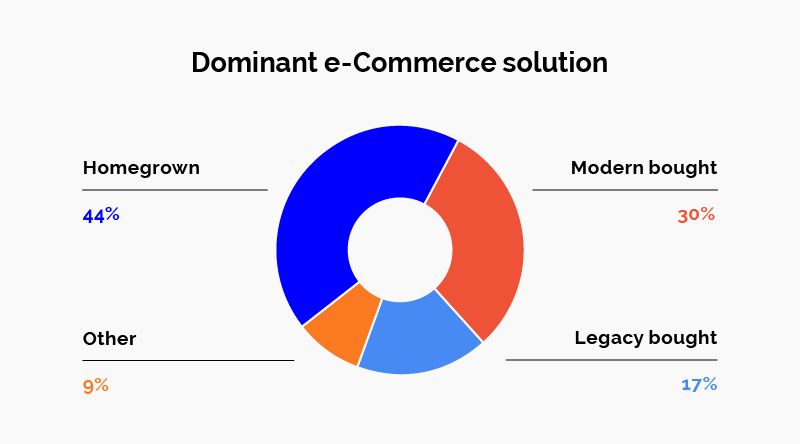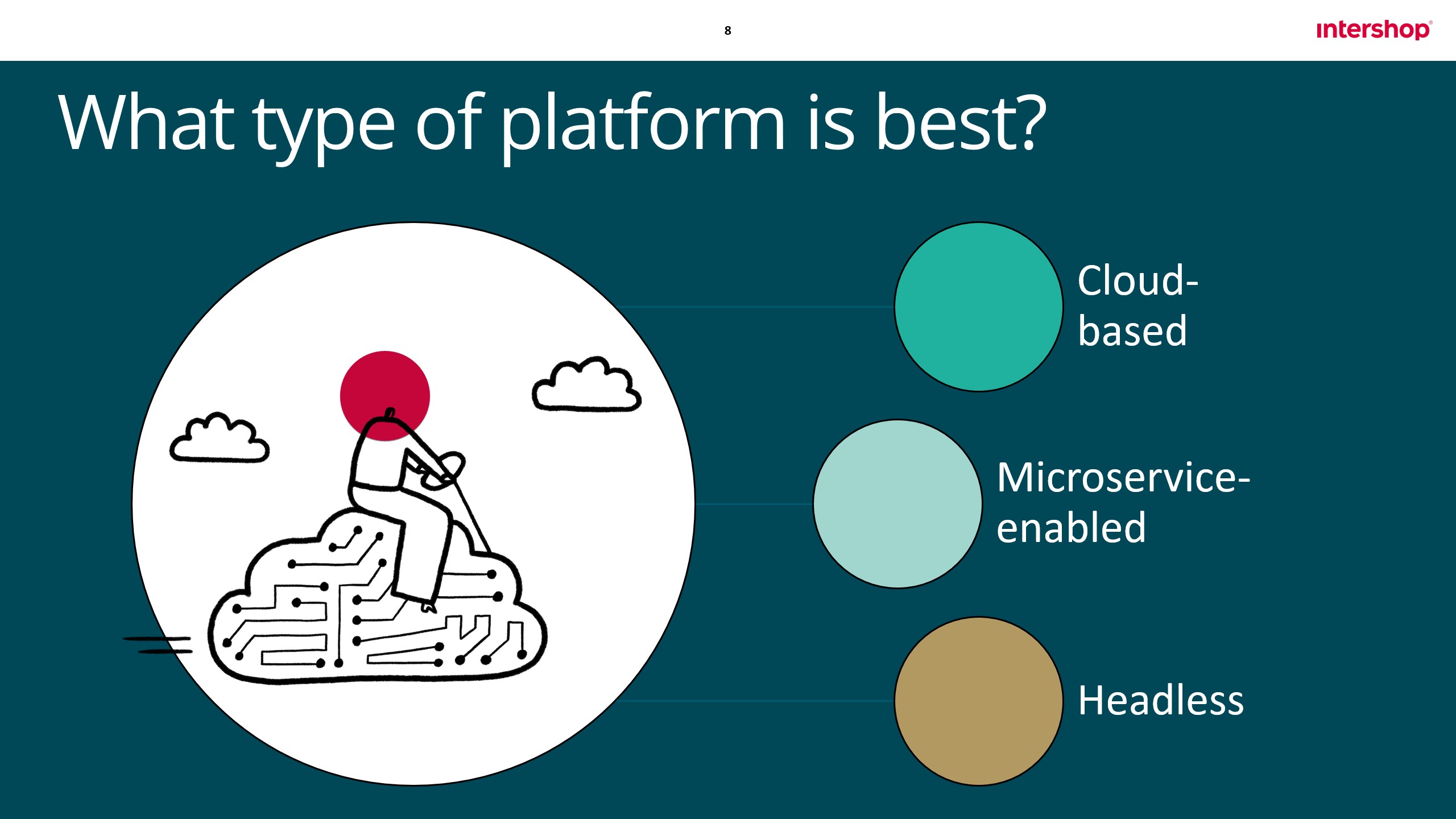Nowadays, technological development is relentlessly fast, and customers have higher expectations due to the accelerated adoption of digital. Customers have indefinite choices, and they expect unique, digital experiences from brands. Here is a guide on how to find a solution that works now into the future.
This article answers the following questions:
- What is a legacy e-commerce platform?
- What is the Total Cost of Ownership (TCO) of a legacy e-commerce platform?
- What type of e-commerce solution is future-proof?
- Why are the best e-commerce platforms hosted in the cloud, microservices-based and headless?
The ideal e-commerce platform should meet your B2B business needs now, and also enables future innovation and advancement. According our research “The State of International E-Commerce in Manufacturing”, most manufacturers still run their homegrown solutions.
 Source: Benchmark report “The State of International E-Commerce in Manufacturing”, Intershop, Evident and Copperberg, 2021 [Download]
Source: Benchmark report “The State of International E-Commerce in Manufacturing”, Intershop, Evident and Copperberg, 2021 [Download]
What is a legacy e-commerce platform?
Legacy e-commerce platforms are outdated versions of software that often lack modern security measures and operational efficiency. Despite past investments, they hinder growth and innovation in today's dynamic market, and often fail to meet the growing requirements of digital B2B commerce.
Since legacy systems are often rigid and cannot be adjusted with time, they become an obstacle to business development. Sustainable success can only be achieved by meeting the constantly growing customer requirements, comprehensively digitizing sales and service processes, and creating optimal conditions for future developments.
Those legacy e-commerce platforms are called “monoliths”. They have been built a decade ago and have grown with many point-to-point integrations into one highly customized block of code.
The most common features of such a monolith are:
- They are built for inside-out communication. Your customers need to adapt to your processes, structures, terms and conditions.
- They are highly specialized and not flexible to changing requirements
- They are tightly coupled - every change you implement has an impact on the whole system.
What is the Total Cost of Ownership (TCO) of a legacy e-commerce platform?
Maintaining a legacy e-commerce platform presents numerous challenges and hidden costs. Typically designed for on-premises hosting, these platforms demand constant attention from your IT team to oversee hardware, software licenses, operating systems, and databases. Safeguarding the security and functionality of multiple systems is an ongoing endeavor. Moreover, the Total Cost of Ownership (TCO) encompasses a wide range of expenses, including software licensing, hosting, maintenance, payment processing, software development, data security (e.g., firewalls, SSL certificates, cybersecurity insurance), and other related expenditures.
Not in plain sight but impactful on the TCO of legacy e-commerce is the dependency on partners or employees with very specific knowledge. IT teams usually refer to this as the “bus factor” (derived from the phrase "in case they get hit by a bus.")
In many firms, there will be an issue with a budget and further investment. A monolith that is run and maintained by IT is also part of their cost center. IT, however, is driven mainly by delivering their services in the most efficient way (also known as lowest price) possible. An e-commerce platform is a tool for sales with different measurements of success.
When the platform becomes challenging to use for customers, is not mobile responsive or slow, investment in changes needs to be done by sales, not IT. Those investments ensure that customers don’t churn, the cost of the order remains low and new cross- and upsell opportunities can be opened by personalization.
What type of e-commerce solution is future-proof?
Choosing a future-proof e-commerce solution depends on your business's size, resources, and growth goals. For newcomers, SaaS solutions offer speed and simplicity, but beware of potential monolithic limitations. Small teams may benefit from pre-packaged solutions, while those with more resources can explore composable components for flexibility. For highly specialized teams, a scalable API architecture provides the ultimate freedom for customization and growth, ensuring adaptability to evolving market demands.
- If you are new to e-commerce - an “all-in-one” SaaS solution will prove practical and fast to deploy because everything is standardized and prepared, without any customization. However, note that this structure could become monolithic in the long run and alteration could be difficult and expensive.
- If you have a small team of software engineers to look after the system part-time, pre-packaged solutions with limited alteration capabilities could work for your business.
- If you have more resources or are willing to outsource, you can choose a platform with composable components, or packaged business capabilities. Composable e-commerce can go live quickly. They come with standard features, but each block can be customized or reworked without affecting the whole system, making it easy to grow over the years.
- If you have a digital team with specialized competencies, a scalable API architecture with minimum base functionality will provide maximum freedom, This infrastructure will give you a vast playground of opportunities to build your microservices-based solution from scratch. Focus on training your task force, so their skills are up-to-date.
When you aim for a highly flexible, customizable e-commerce platform, the first and the final solution might not be the one for you. You don’t want something too rigid or complicated to allow rapid adaptation to changes.
Why are the best e-commerce platforms hosted in the Cloud, microservices-based and headless?
Regardless of the level of pre-configuration you opt for, there are three principles that your solution needs:

Why you should opt for a Cloud-based e-commerce solution
Your new e-commerce platform should be hosted in the Cloud, not locally because it is cheaper. You can go live with basic functionalities (MVP) that cater for the most important needs of your customers and pay only for that. With growing revenue, your solution can grow with you - both in terms of functionality and performance.
A Cloud-based e-commerce solution requires less from your IT team. You don’t need specialists who understand in detail how the application works, or database experts, or even IT architects. After taking care of the seamless integration into all your other tools such as ERP, CRM, or PIM, their responsibility can be reduced to manage the Service-Level Agreements (SLA) with the solution provider.
Executives can improve their business planning much easier with a Cloud-based e-commerce solution in place because it is cost-predictable. Most vendors will be able to provide you with a list of expected costs concerning the platform’s KPIs like turnover or traffic.
There is another benefit a cloud-based e-commerce solution has: Your costs shift from CAPEX to OPEX. What does that mean?
You no longer acquire a good that you own but shift these costs to being operational ones. This enables all stakeholders (Sales, Marketing, Aftermarket, Services) to contribute to the subscription.
Why you should opt for a microservice-enabled e-commerce solution
Microservices are a great way to combine functionalities of your choice, best-of-breed applications from third parties with standard features provided by the e-commerce vendor.
They are horizontally scalable - and here’s an example: If you offer personalized or dynamic prices on your products and services, the calculation can easily slow your page, reducing the customer experience. So if your online shop grows to a level where the initial price calculation affects the customer, you can exchange this feature with a more powerful one - without adjusting all the rest, too.
Microservice-enabled e-commerce will reduce the dependency on your IT because it requires only a few developers, in-house or at an agency, to create, deploy and update them.
Microservices will boost your agility to test and learn because you can leverage technologies like AI, noSQL databases, or voice recognition without affecting the whole system, and you are independent of your ecosystem. So keep what is good, throw away what is not working and innovate without much risk!
Why you should opt for headless commerce
A headless commerce platform enables you to provide different frontends or user interfaces for different commerce channels, because they are separated from its logic. You can have all your robust business processes from a web application, a mobile app or PWA, a terminal on a machine or via voice control. Imagine your device enabling you to buy consumables directly via a touch screen!
Headless commerce is fast because you can make sure that data only flows where it is needed. To provide a great digital experience in your online shop, you will have other tools in addition to an e-commerce engine: CRM, documentation management, ticket management systems, CPQ, IoT Monitoring.... A separated “head” will receive all necessary information directly from each source. This ensures that each backend system remains lean and fast. For example, a customer educating themself on a product detail page will receive the images from a DAM server, product information from the PIM, configuration from the CPQ and only the actual transaction is done by the e-commerce.
Headless commerce also allows you to hire better talent, for you need UX and graphic designers to create teasing user interfaces and backend developers that can focus on your business processes. This way, you can iterate, experiment, fail fast, learn fast and benefit from shorter release cycles.
To wrap it up
If you want to replatform to a future-proof B2B e-commerce platform, we advise you to:
- Start simple with a lot of out-of-the-box features, go live fast, grow complex in the future, based on the needs of your customers.
- Be sure to focus your efforts on the functionalities that better deliver your USPs to the customers.
- Don’t waste time (and money) in developing functionalities that are commodities.
- Use standard API to stay agile, fast and responsive to changing needs and eliminate the “bus factor”.
For more detailed guidance on e-commerce replatforming, check out our comprehensive guide for B2B decision makers!
For those seeking deeper insights into selecting a future-proof B2B e-commerce platform, we offer a complimentary webinar recording. This resource expands upon the topics covered in this article, providing extensive examples and insights on initiating and executing a successful replatforming project. Led by a seasoned e-commerce expert with a proven track record in rescuing multiple replatforming endeavors, this webinar offers invaluable guidance for your e-commerce journey.

![[Video] How to select a future-proof commerce platform](https://hubspot-no-cache-eu1-prod.s3.amazonaws.com/cta/default/4791871/2bd7928c-6660-44d9-be02-8cbdb379325a.png)





